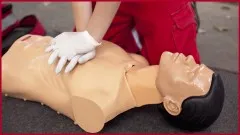
Wilderness First Aid - Medical Emergencies 
This Wilderness First Aid course provides online learning and skill training to help students identify and treat common medical emergencies in the wilderness. Students will learn to recognize the difference between blunt and penetrating trauma, common injuries of the chest, abdomen, and pelvis, and signs and symptoms of head trauma. They will also learn when a condition requires immediate evacuation. ▼
ADVERTISEMENT
Course Feature
![]() Cost:
Cost:
Free
![]() Provider:
Provider:
Coursera
![]() Certificate:
Certificate:
Paid Certification
![]() Language:
Language:
English
![]() Start Date:
Start Date:
4th Sep, 2023
Course Overview
❗The content presented here is sourced directly from Coursera platform. For comprehensive course details, including enrollment information, simply click on the 'Go to class' link on our website.
Updated in [May 25th, 2023]
This Wilderness First Aid - Medical Emergencies course provides students with the knowledge and skills to identify and treat common traumatic injuries in the wilderness. Students will learn to differentiate between blunt and penetrating trauma, and how to recognize and treat chest, abdomen, and pelvis injuries. They will also be taught about the signs and symptoms of different types of head trauma, and when a condition would warrant immediate evacuation. By the end of the course, students will have the confidence to respond to medical emergencies in the wilderness.
[Applications]
Students who complete this course will be able to apply their knowledge of wilderness first aid in a variety of settings, such as camping, hiking, and backpacking trips. They will be able to recognize and respond to medical emergencies in the wilderness, and be able to provide basic first aid care for common injuries. Additionally, they will be able to identify when a condition requires evacuation and be able to provide basic care until help arrives.
[Career Paths]
1. Wilderness Emergency Medical Technician (WEMT): WEMTs are trained to provide medical care in remote and challenging environments. They are responsible for providing medical care to patients in the wilderness, and are often the first responders in medical emergencies. WEMTs must be able to assess and treat a variety of medical conditions, and must be able to recognize and respond to environmental hazards. WEMTs are in high demand as more people are engaging in outdoor activities, and the demand for WEMTs is expected to continue to grow.
2. Wilderness Search and Rescue Technician (WSAR): WSARs are responsible for locating and rescuing people who are lost or injured in the wilderness. They must be able to use a variety of search and rescue techniques, and must be able to assess and treat medical conditions in the wilderness. WSARs must also be able to recognize and respond to environmental hazards. The demand for WSARs is expected to increase as more people are engaging in outdoor activities.
3. Wilderness Adventure Guide: Wilderness Adventure Guides are responsible for leading groups of people on outdoor adventures. They must be knowledgeable about the environment and be able to recognize and respond to environmental hazards. They must also be able to assess and treat medical conditions in the wilderness. The demand for Wilderness Adventure Guides is expected to increase as more people are engaging in outdoor activities.
4. Wilderness Survival Instructor: Wilderness Survival Instructors are responsible for teaching people how to survive in the wilderness. They must be knowledgeable about the environment and be able to recognize and respond to environmental hazards. They must also be able to assess and treat medical conditions in the wilderness. The demand for Wilderness Survival Instructors is expected to increase as more people are engaging in outdoor activities.
[Education Paths]
1. Bachelor of Science in Emergency Medical Services: This degree program provides students with the knowledge and skills to become an emergency medical technician (EMT) or paramedic. Students will learn about medical terminology, anatomy and physiology, medical ethics, and patient assessment. They will also gain hands-on experience in the field, such as responding to medical emergencies, providing basic life support, and transporting patients. This degree is becoming increasingly popular as the demand for emergency medical services continues to grow.
2. Master of Science in Wilderness Medicine: This degree program focuses on the medical care of patients in remote and austere environments. Students will learn about the principles of wilderness medicine, including risk management, environmental physiology, and medical decision-making. They will also gain hands-on experience in the field, such as responding to medical emergencies, providing basic life support, and transporting patients. This degree is becoming increasingly popular as more people are engaging in outdoor activities and the need for specialized medical care in remote areas increases.
3. Doctor of Nursing Practice in Wilderness Medicine: This degree program focuses on the advanced practice of nursing in remote and austere environments. Students will learn about the principles of wilderness medicine, including risk management, environmental physiology, and medical decision-making. They will also gain hands-on experience in the field, such as responding to medical emergencies, providing advanced life support, and transporting patients. This degree is becoming increasingly popular as more people are engaging in outdoor activities and the need for specialized medical care in remote areas increases.
4. Master of Public Health in Wilderness Medicine: This degree program focuses on the public health aspects of wilderness medicine. Students will learn about the principles of wilderness medicine, including risk management, environmental physiology, and medical decision-making. They will also gain hands-on experience in the field, such as responding to medical emergencies, providing basic life support, and transporting patients. This degree is becoming increasingly popular as more people are engaging in outdoor activities and the need for specialized medical care in remote areas increases.
Pros & Cons

Excellent for back country environments

Responsible care of others

Definitions of medical terms

Not in a medical environment

Need to act before it's too late
Course Provider

Provider Coursera's Stats at AZClass
Discussion and Reviews
0.0 (Based on 0 reviews)
Explore Similar Online Courses

Securing Java Web Applications Through Authentication

Certified Information Systems Security Professional CISSP

Python for Informatics: Exploring Information

Social Network Analysis

Introduction to Systematic Review and Meta-Analysis

The Analytics Edge

DCO042 - Python For Informatics

Causal Diagrams: Draw Your Assumptions Before Your Conclusions

Whole genome sequencing of bacterial genomes - tools and applications

First Aid and Bloodborne Pathogens (BBP)

2 How To Save A Life - Advanced


Start your review of Wilderness First Aid - Medical Emergencies